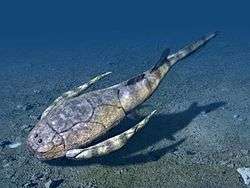Carbonemys
| Carbonemys Temporal range: Mid-Late Paleocene (Peligran-Itaboraian) ~60–58 Ma | |
|---|---|
 | |
| Life restoration of Carbonemys | |
| Scientific classification | |
| Kingdom: | Animalia |
| Phylum: | Chordata |
| Class: | Reptilia |
| Order: | Testudines |
| Suborder: | Pleurodira |
| Family: | Podocnemididae |
| Genus: | †Carbonemys Cadena et al., 2012 |
| Type species | |
| †Carbonemys cofrinii Cadena et al., 2012 | |
Carbonemys cofrinii is an extinct podocnemidid turtle known from the Middle Paleocene Cerrejón Formation of northeastern Colombia. The formation is dated at around 60 to 58 million years ago, starting at about five million years after the KT extinction event.[1]
Discovery
In 2005, the holotype specimen was discovered in the Cerrejón coal mine by a North Carolina State University doctoral student named Edwin Cadena. It had a shell that measured about 1.72 metres (5 ft 8 in), making it one of the world's largest turtles.[2][3]
The jaws of Carbonemys were massive and would be powerful enough to eat crocodylians, that were abundant in the first neotropical forest of the Cerrejón Formation.[4] This turtle coexisted with the giant boid, Titanoboa.
References
- ↑ Cadena, E. A.; Ksepka, D. T.; Jaramillo, C. A.; Bloch, J. I. (2012). "New pelomedusoid turtles from the late Palaeocene Cerrejón Formation of Colombia and their implications for phylogeny and body size evolution". Journal of Systematic Palaeontology. 10 (2): 313. doi:10.1080/14772019.2011.569031.
- ↑ "Researchers reveal ancient giant turtle fossil". Phys.Org. 17 May 2012. Retrieved 18 May 2012.
- ↑ Maugh II, Thomas H. (18 May 2012). "Researchers find fossil of a turtle that was size of a Smart car". LA Times. Retrieved 18 May 2012.
- ↑ "Car-sized Turtle Found in Colombian Coal Mine : Discovery News". News.discovery.com. 2012-05-18. Retrieved 2012-06-14.
This article is issued from
Wikipedia.
The text is licensed under Creative Commons - Attribution - Sharealike.
Additional terms may apply for the media files.


.jpg)
